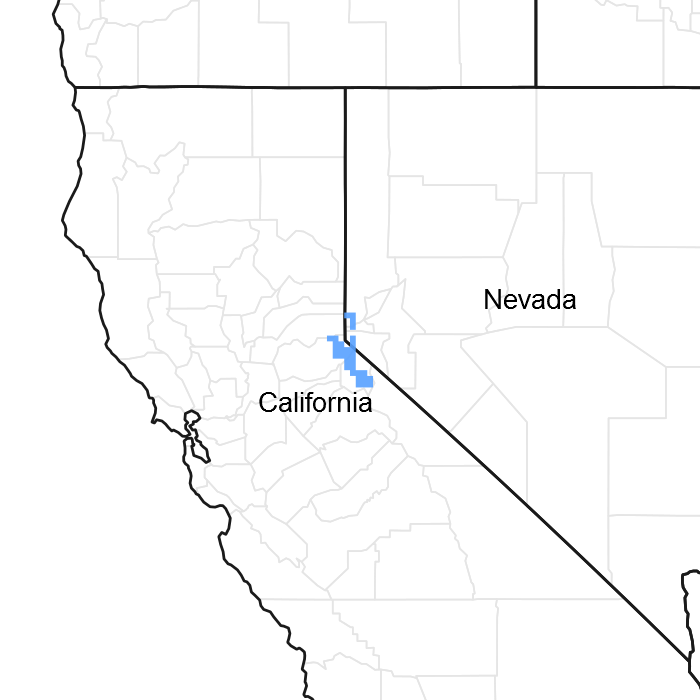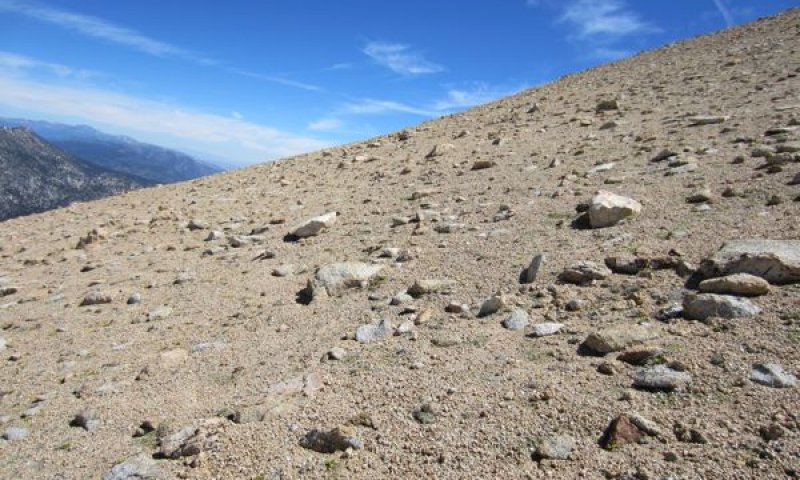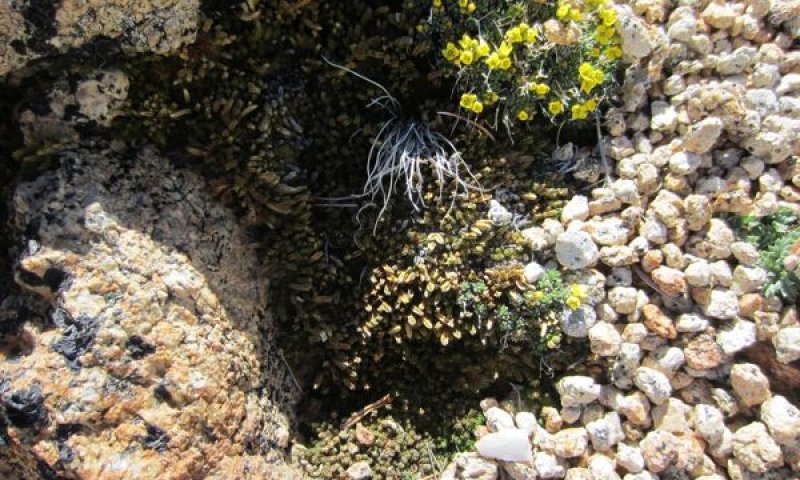

Natural Resources
Conservation Service
Ecological site R022AA200CA
Alpine Scree
Accessed: 12/21/2025
General information
Approved. An approved ecological site description has undergone quality control and quality assurance review. It contains a working state and transition model, enough information to identify the ecological site, and full documentation for all ecosystem states contained in the state and transition model.

Figure 1. Mapped extent
Areas shown in blue indicate the maximum mapped extent of this ecological site. Other ecological sites likely occur within the highlighted areas. It is also possible for this ecological site to occur outside of highlighted areas if detailed soil survey has not been completed or recently updated.
MLRA notes
Major Land Resource Area (MLRA): 022A–Sierra Nevada and Tehachapi Mountains
Major Land Resource Area 22A, Sierra Nevada Mountains, is located predominantly in California and a small section of western Nevada. The area lies completely within the Sierra Nevada Section of the Cascade-Sierra Mountains Province. The Sierra Nevada range is highly asymmetrical with a long, gentle western slope, and a very abrupt eastern slope. The Sierra Nevada consists of hilly to steep mountains and occasional flatter mountain valleys. Elevation ranges between 1,500 and 9,000 ft throughout most of the range, but certain peaks often exceed 12,000 ft. The highest point in the continental US occurs in this MLRA (Mount Whitney, 14,494 ft). Most of the Sierra Nevada is dominated by granitic rock of the Mesozoic age, known as the Sierra Nevada Batholith. The northern half is flanked on the west by a metamorphic belt, which consists of highly metamorphosed sedimentary and volcanic rocks of Paleozoic and Mesozoic ages. Additionally, glacial activity of the Pleistocene has played a major role in shaping Sierra Nevada features, including cirques, arêtes, and glacial deposits and moraines. Average annual precipitation ranges from 20 to 80 inches in most of the area, with increases along elevational and south-north gradients. Soil temperature regime ranges from mesic, frigid, and cryic. Due to the extreme elevational range found within this MLRA, Land Resource Units (LRUs) were designated to group the MLRA into similar land units.
LRU "A" Sierran Alpine: This LRU occurs at the highest elevations of the Sierra Nevada, above treeline on upper mountain slopes, exposed ridges and mountain peaks. This LRU begins at the alpine treeline ecotone, which occurs at approximately 11,000 feet in the south and central areas and approximately 9,800 feet in the north, and extends up to 14,494 feet (Mount Whitney). Mean annual air temperature (MAAT) ranges from 29 to 35 degrees F, mean annual precipitation (MAP) ranges from 39 to 60 inches, and the frost free season is 20 to 30 days.
Ecological site concept
This ecological site occurs above timberline on windswept ridges, shoulders and mountain peaks at elevations typically between 9,800 and 12,000 feet. Slopes range from 15 and 75 percent. Soils are derived from granitic parent material, and are shallow to moderately deep over paralithic granitic bedrock, with a sandy skeletal particle size class. Wind exposure, cold temperatures, high solar radiation, a short growing season, coarse granitic soils with low water holding capacity, and slope instability limit the vegetation community to a very sparse cover of dwarf alpine subshrubs, perennial forbs and grasses. Vegetation composition is variable, with low constancy across sites, but rosy buckwheat (Eriogonum rosense), Nevada podistera (Podistera nevadensis), granite prickly phlox (Linanthes pungens), and fewseed draba (Draba oligosperma) are among the more frequently occurring species.
Associated sites
| F022AC001CA |
Cryic Sandy Mountain Slopes Occurs on lower elevation slopes at or near treeline. An open whitebark pine (Pinus albicaulis) forest dominates, with very little understory vegetation. |
|---|---|
| R022AA201CA |
Sandy Shallow Alpine Mountain Slopes Occurs on adjacent slightly lower elevation slopes with shallow soils over decomposed granite. Krummholz whitebark pine (Pinus albicaulis) characterizes the vegetation. |
| R022AC204CA |
Cryic, Umbric Or Andic Slopes Occurs on lower elevation slopes with moderate to very deep, cryic skeletal soils over volcanic or granitic bedrock. The vegetation is a productive shrub-grassland dominated by mountain big sagebrush (Artemisia tridentata ssp. vaseyana) and antelope bitterbrish (Purshia tridentata). |
| R022AY025NV |
MAHOGANY THICKET Occurs on landscape positions where snow accumulates. Curl-leaf mountain mahogany (Cercocarpus ledifolius) dominates this shrubland community. |
Similar sites
| R022AY032NV |
ALPINE RIDGE Occurs on similar landforms, but is found on volcanic soils in more southerly locations. Production and diversity potential are higher due to greater soil moisture holding capacity of the soil. |
|---|---|
| R022AA201CA |
Sandy Shallow Alpine Mountain Slopes This site occurs on similar soils, but in lower or more protected topographic positions that allow for the development of krummholz whitebark pine (Pinus albicaulis) communities. The herbaceous component of these sites is very similar. |
Table 1. Dominant plant species
| Tree |
Not specified |
|---|---|
| Shrub |
Not specified |
| Herbaceous |
(1) Eriogonum rosense |
Click on box and path labels to scroll to the respective text.


